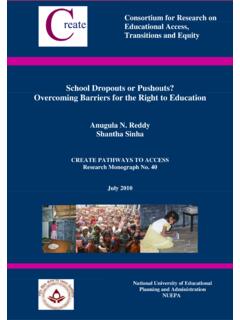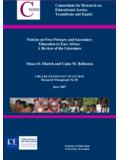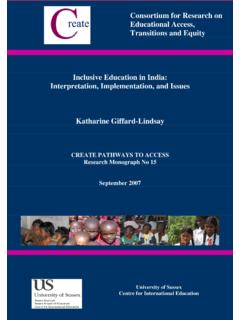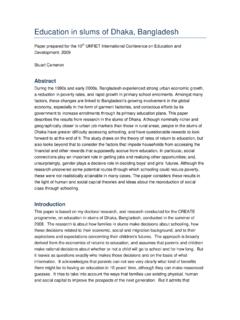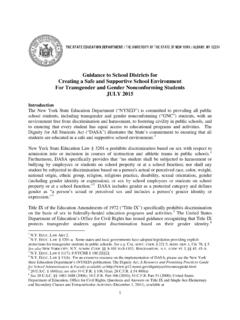Transcription of Bullying and School Attendance: A Case Study of Senior ...
1 Consortium for Research onEducational Access,Transitions and EquityBullying and School Attendance: A case Study of Senior High School Studentsin GhanaM ir ad DunneCynthia Bosumtwi-SamRicardo SabatesAndrew OwusuCREATE PATHWAYS TO ACCESSR esearch Monograph 2010 University of SussexCentre for International EducationThe Consortium for Educational Access, Transitions and Equity (CREATE) is a Research ProgrammeConsortium supported by the UK Department for International Development (DFID). Its purpose is to undertakeresearch designed to improve access to basic education in developing countries. It seeks to achieve this throughgenerating new knowledge and encouraging its application through effective communication and disseminationto national and international development agencies, national governments, education and developmentprofessionals, non-government organisations and other interested to basic education lies at the heart of development. Lack of educational access, and securely acquiredknowledge and skill, is both a part of the definition of poverty, and a means for its diminution.
2 Sustained accessto meaningful learning that has value is critical to long term improvements in productivity, the reduction ofinter-generational cycles of poverty, demographic transition, preventive health care, the empowerment ofwomen, and reductions in CREATE partnersCREATE is developing its research collaboratively with partners in Sub-Saharan Africa and South Asia. Thelead partner of CREATE is the Centre for International Education at the University of Sussex. The partners are:The Centre for International Education, University of Sussex: Professor Keith M Lewin (Director)The Institute of Education and Development, BRAC University, Dhaka, Bangladesh: Dr Manzoor AhmedThe National University of Educational Planning and Administration, Delhi, India: Professor R GovindaThe Education Policy Unit, University of the Witwatersrand, South Africa: Dr Shireen MotalaThe Universities of Educationat Winneba and Cape Coast, Ghana: Professor Jerome Djangmah,Professor Joseph Ghartey AmpiahThe Institute of Education, University of London: Professor Angela W LittleDisclaimerThe research on which this paper is based was commissioned by theConsortium for Research on EducationalAccess, Transitions and Equity (CREATE ).
3 CREATE is funded by the UKDepartment for International Development (DFID) for the benefit of developing countries and is coordinatedfrom the Centre for International Education, University of Sussex. The views expressed are those of theauthor(s) and not necessarily those of DFID, the University of Sussex, or the CREATE Team. Authors areresponsible for ensuring that any content cited is appropriately referenced and acknowledged, and that copyrightlaws are respected. CREATE papers are peer reviewed and approved according to academic will be granted to reproduce research monographs on request to the Director of CREATE providingthere isno commercial benefit. Responsibility for the content of the final publication remains with authors andthe relevant Partner CREATE 2010 ISBN: 0-901881-48-1 Address for correspondence:CREATE,Centre for International Education,Department of EducationSchool of Education & Social WorkEssex House, University of Sussex, Falmer BN1 9QQ,United KingdomTel:+ 44 (0) 1273877984 Fax:+ 44 (0) 1273 877534 Author contact CREATE using the details above if you require a hard copy of this and School Attendance: A case Study of Senior High School Studentsin GhanaM ir ad DunneCynthia Bosumtwi-SamRicardo SabatesAndrew OwusuCREATE PATHWAYS TO ACCESSR esearch Monograph No 41 July The Ghanaian Methodology and Estimation method and hypothesis Bullying (frequency and type) and School Bullying and School absenteeism: Emotional problems and friend of TablesTable 1: Proportion of School absenteeism by Bullying and 2.
4 Ordered logit odd ratios [standard errors] estimates of School attendance in SHS inGhanaby 3: Ordered logit odd ratios [standard errors] estimates of School attendance in SHS inGhana by gender: frequency of Bullying , emotional problems and 4: Ordered logit odd ratios [standard errors] estimates of School attendance in SHS inGhana by gender: type of Bullying , emotional problems and of FiguresFigure 1: Predicted probability of School absenteeism for girls in SHS with 2: Predicted probabilityof School absenteeism for boys and girls in SHS by type ofbullying and friend of AcronymsAIDS-Acquired Immune Deficiency SyndromeBBC-British Broadcasting CorporationBECE-Basic Education Certificate ExaminationCDC-Centres for Disease Control and PreventionCRC-Convention on the Rights of the ChildCREATE-Consortium for Research on Educational Access, Transitions and EquityDFID-Department for International EducationEFA-Education for AllGES-Ghana Education ServiceGET-Ghana Educational TrustGER-Gross Enrolment RatioGSHS-Global School -based Student Health SurveyHBSC-Health Behaviour in School -Aged ChildrenHIV-Human Immunodeficiency VirusJSS-Junior Secondary SchoolMDG-Millennium Development GoalMoE-Ministry of EducationNER-Net Enrolment RatioSS- Senior SecondarySSS- Senior Secondary SchoolUK-United KingdomUPE-Universal Primary EducationUS-United StatesUN-United NationsUNESCO-United Nations Educational.
5 Scientific andCultural OrganisationUNICEF-United Nations Children s FundWHO-World Health OrganisationvAcknowledgementsThis article is based on the 2008 Ghana Global School -based Student Health Survey (GSHS)and we would like to express our sincere gratitude to all the persons and organisations thatcontributed to the successful execution of the 2008 Ghana GSHS. This was jointly funded byMiddle Tennessee State University, Ghana Education Service (GES) and the World HealthOrganisation (WHO). Additional financial contribution was provided by Captain Tsakosthrough the Maria Tsakos Foundation in Athens, Greece. Technical assistance was providedby the United States Centres for Disease Control and Prevention (CDC). We are also gratefulto the management of the Ghana Education Service Headquarters, all regional and districtdirectors of Ghana Education Service as well as the heads and teachers of the schools thatparticipated in the earlier version of this paper was produced by Cynthia Bosumtwi-Samas part of herdissertation to achieve a MA in International Education and Development during 2009.
6 Weare grateful to Sarah Humphreys for her comments and suggestions for improving this research monograph adds a dimension to the analysis of access to education in Ghana byexploring some aspects of Bullying on attendance . Sustaining high levels of access toeducation requires understanding of both the supply and demand for education. Supply sideissues ( building classrooms, providing teachers and learning materials) are often betterunderstood than some demand side issues ( relevance of curricula and pedagogy tochildren s life world, motivation and sense of self worth and value). Issues concerned withsafety, self esteem, peer support, andviolence and Bullying all influence demand and may bereflected in poor attendance and from the 2008 Ghana Global School -based Student Health Survey are used to explorehow attendance varies with self reported amounts ofbullying at School . The analysis revealssurprisingly high levels of reported Bullying and differences between girls and boys both inthe incidence and responses to self reported Bullying .
7 Often the patterns are not simple toexplain and involve interactions with emotional security and other characteristics ofindividuals. These invite follow up work to understand the dynamics of the social psychologythe interactions between girls, between boys, between girls and boys, and between childrenand adults. Allthese shape motivation and may lead to circumstances that result in absenceand an increased likelihood of drop paper therefore opens a door on issues that are expressed at the individual, classroom andschool level that are likely to affect access broadly defined, and which may well influence thepatterns of demand for schoolings, particularly amongst boys and girls most likely to bebullied. Areality needs to bemade of the child friendly schools that UNICEF child seeking schools that CREATEhas argued for need to embrace the idea thatsustained and universal access requires actions on both the supply and demand side thatrecognises push factors that may undermine motivation and self esteem in schoolenvironments that should be safe and LewinDirector of CREATEC entre for International EducationUniversity of SussexviiSummaryThis paper focuses on Senior high School students and the ways that Bullying affects theirschool attendance .
8 Selected items fromthe2008 Ghana Global School -based Student HealthSurvey are analysed first to explore the relationships between the duration and type ofbullying and School attendance . Second, we investigate whether having emotional problems,inaddition to being bullied, incrementally affects the relationship between Bullying andschool attendance . Third, we explore the mitigating influence of peer friendships on theserelationships. In all cases we provide a gender results showthat Bullying is associated with increased absenteeism for both boys andgirls. The analysis of reported emotional problems, however, shows distinct genderdifferences. For boys,increases in emotional problems are not associated with increasedabsenteeismfor those who are bullied. On the other hand, for girls emotional problems werestrongly associated with absenteeism and more so for girls who had not reported beingbullied. The third strand of our analysis also showed gender differences in which absenteeismassociated with Bullying was mitigated by the support of friends for boys but not to the samedegree for girls, especially those girls who had reported being psychologically addition to the threat to School access caused by Bullying , thegender dimensions of thelatter two sets of findings suggest a School environment in which peer friendship andemotional well-being are intertwined in complex ways.
9 While there is little or no researchwithin the Ghanaian context, supported by research from elsewhere, we suggest that peerfriendships for girls may be comprised of more non- physical , social and verbal interactionwithin which it might be more difficult to pinpoint Bullying . That peer interactions mightinclude a mixture of support and Bullying could explain why there is a strong influence ongirls emotional well-being and hence their School and School attendance : A case Study of Senior High SchoolStudents in and psychological Bullying are prevalent in many extentofbullyinghas been explicitly acknowledged in the international declarations and treatiesdirected at protecting children (and also adults) from all forms of violence. These include theUnited Nations (1989)Convention on the Rights of the Child;World Health Organisation(1999)Violence Prevention: An Important Element of a Health Promoting School ; UnitedNations (1994)Declaration on the Elimination of Violenceagainst Women; UNICEF ( )Child Friendly the face of the international mandate for safe learning environments, the reality for manyschool students is quite different.
10 Many experience Bullying and many other forms ofviolence on a day-to-day basis within School (see for example, Leach and Mitchell, 2006,Dunne, 2007). Bullying , aggression and other forms of violence in schools can blight studentexperiences of formal education and their abilities to make the best of the opportunities theyhave (Commission on Children and Violence,1995; Department for Children, Schools andFamilies, 2007; United Nations, 2005). More specifically, violence against students mayresult in higher levels of absenteeism (Rigby and Slee, 1993), greater truancy (Cullingfordand Morrison, 1996; Green, 2006)and increased likelihood of drop out (Leach and Mitchell,2006)which aredescribed by Lewin (2007) as forms of silent exclusion from School , all ofwhich contribute to less effective learning. Levels of absenteeism have been shown toincrease with the severity of victimisation which in turn has been related to depression,anxiety, sadness, loneliness and general low self-esteem (Bond,et al.)



